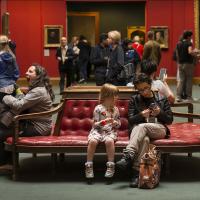This week, as a result of the uncertain situation with the Covid outbreak, the IOM Photographic Society postponed its meeting. The alternative offering was to tune in to a Zoom session on the subject of street photography which proved very interesting and well presented.
Street photography is a specialist niche and one I personally and I suspect many others - have found difficult, with several legal and ethical questions always to be addressed. In essence, street photography is photography of random incidents, where the co-incidence of people, behaviour, architecture and landscape come together at a moment in time to create a story or an event worthy of documenting with an image. Counter-intuitively, neither people nor streets are essential to a street image it is the juxtaposition of the arrangement of the elements within the image to create the story intended by the photographer which is key. The result may be amusing, dramatic, stimulating or inspirational and sometimes with a big question mark as to whether the viewers interpretation of the image is the same as the authors.
Legally, a photographer is able to take an image anywhere in Britain in public places, without needing permission, though with certain exceptions such as Trafalgar Square and Parliament Square if the images are for commercial use. Commercial use permission (and perhaps charges) will also apply in places such as the Royal Parks and National Trust properties. Be aware that taking pictures of sensitive subjects such as military establishments may lead to questions from security staff. The legal position changes on private property where the permission of the property owner is required and which often includes places such as shopping centres and office complexes. Using a tripod is likely to be a particular concern as there are health and safety issues for other users of the premises as well as an implied professional / commercial approach, but a request to allow photography, accompanied by a big smile and an explanation, may well prove successful.
Taking photographs of strangers in public places without their consent (i.e. 'candid photography') is controversial but legal in most countries and protected by freedom of expression, but there are usually limits on how such photos may be used, in particular if privacy or harassment are issues. There is no law prohibiting photographing children in public spaces, but this raises obvious social and ethical queries, and may result in conflict or aggressive behaviour from those involved, so care, consideration and respect will be necessary, and if in doubt, dont.
The image Art Appreciation by Sue Jones is an excellent example of a candid shot inside an art gallery that provides an amusing slant on culture whilst Ruth Nicholls image of a schoolboy in Cuba is almost iconic in its story-telling, and the different interpretations possible eagerness to get to school, danger with traffic, the exhaust pollution from old cars all featuring, and showing street photography as a worthy genre.
Our next meeting is planned for 10th March when Ray Davies is to judge the third Open Competition for both prints and digital images. This may be subject to change depending on the Covid situation, so please check our website www.iomps.com or our Facebook page for details of any update or change to the programme. Our meetings are held the St John Ambulance HQ on Glencrutchery Road, starting at 7:00 pm and are open to the public (non-members with a modest entry fee), and all will be given a very warm welcome.
The Isle of Man Photographic Society is supported by the Arts Council
Chris Blyth
CAPTIONS:
IMAGE 01: 'Art Appreciation' by Sue Jones
IMAGE 02: 'Schooltime Havana' by Ruth Nicholls


